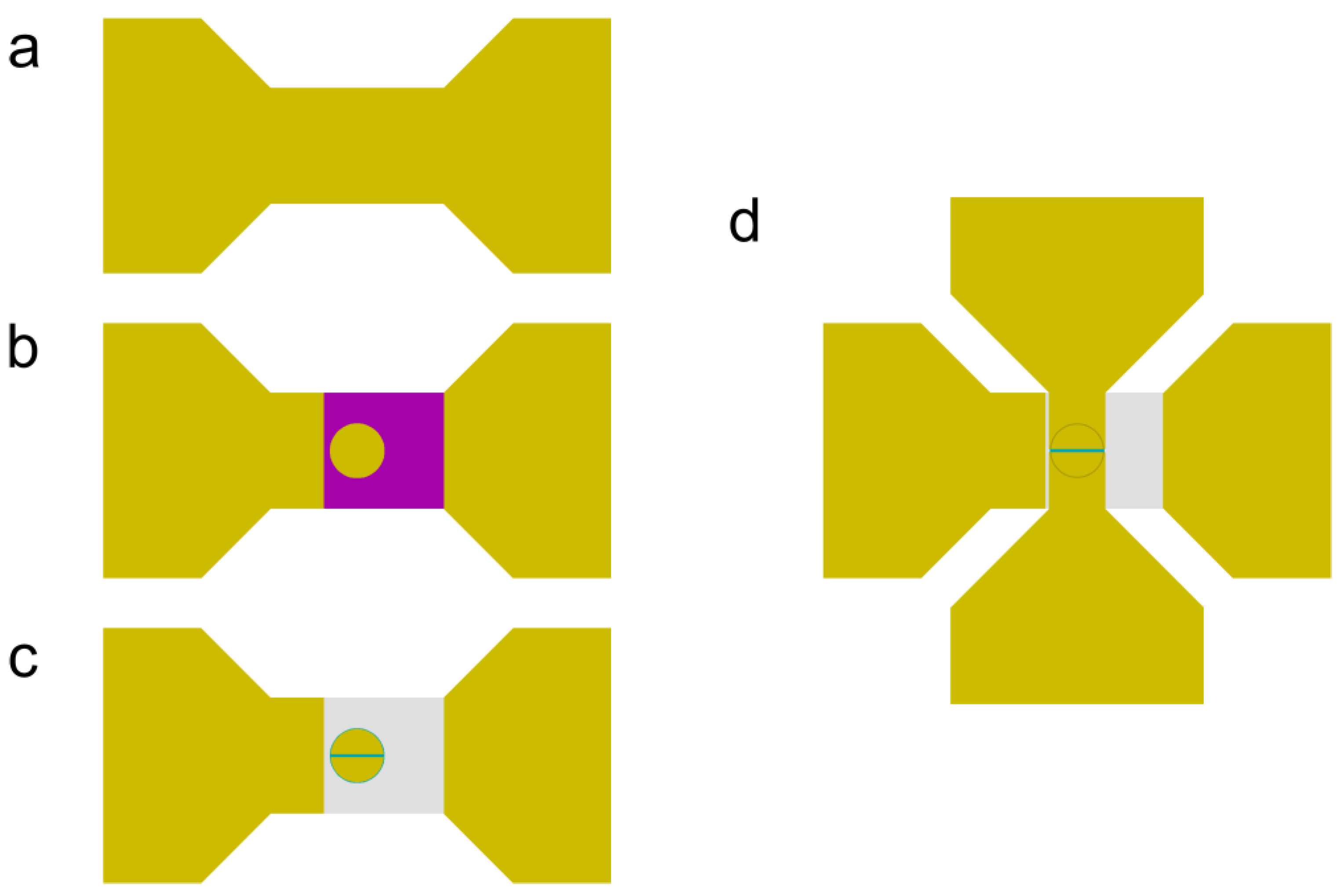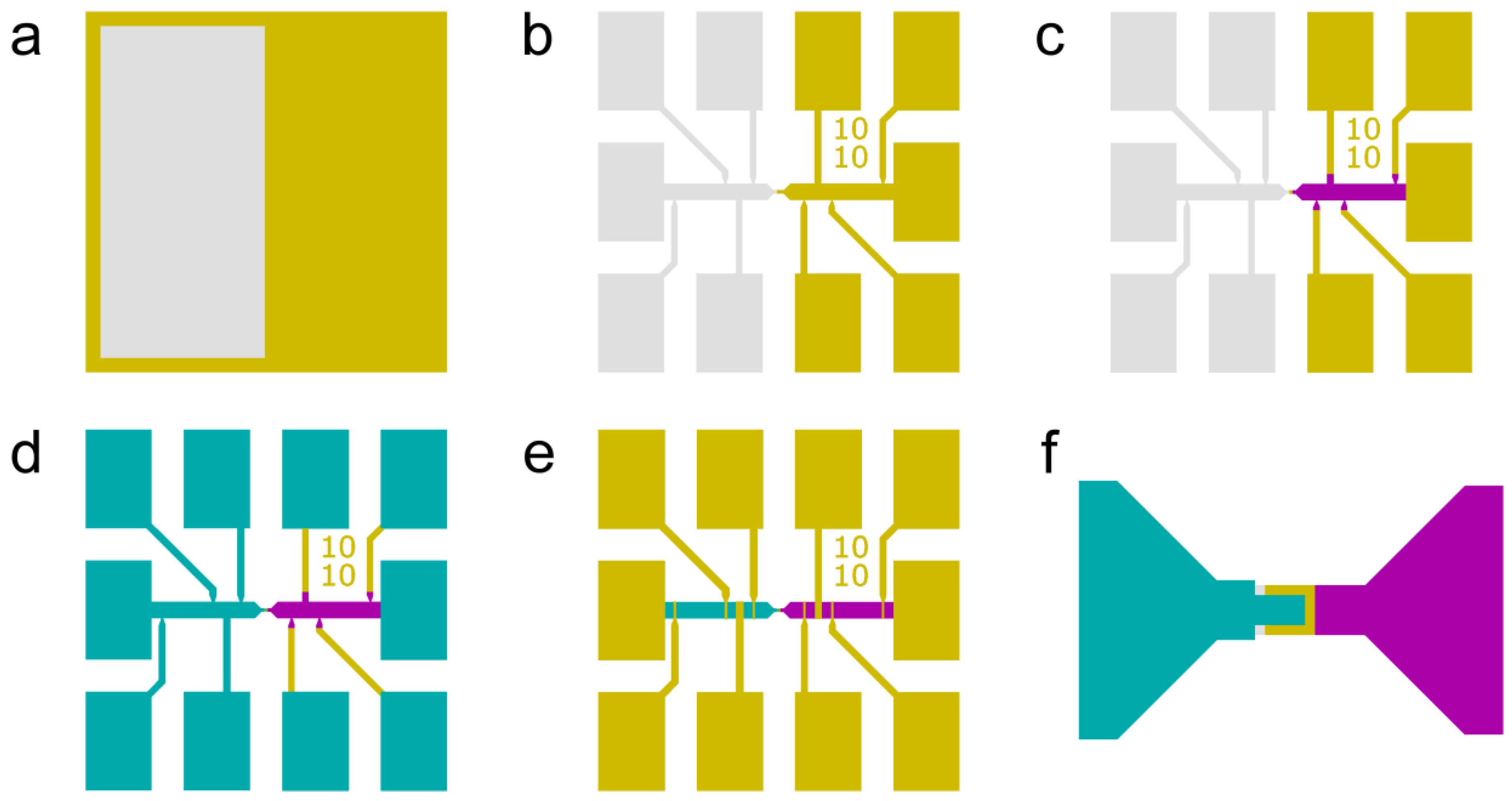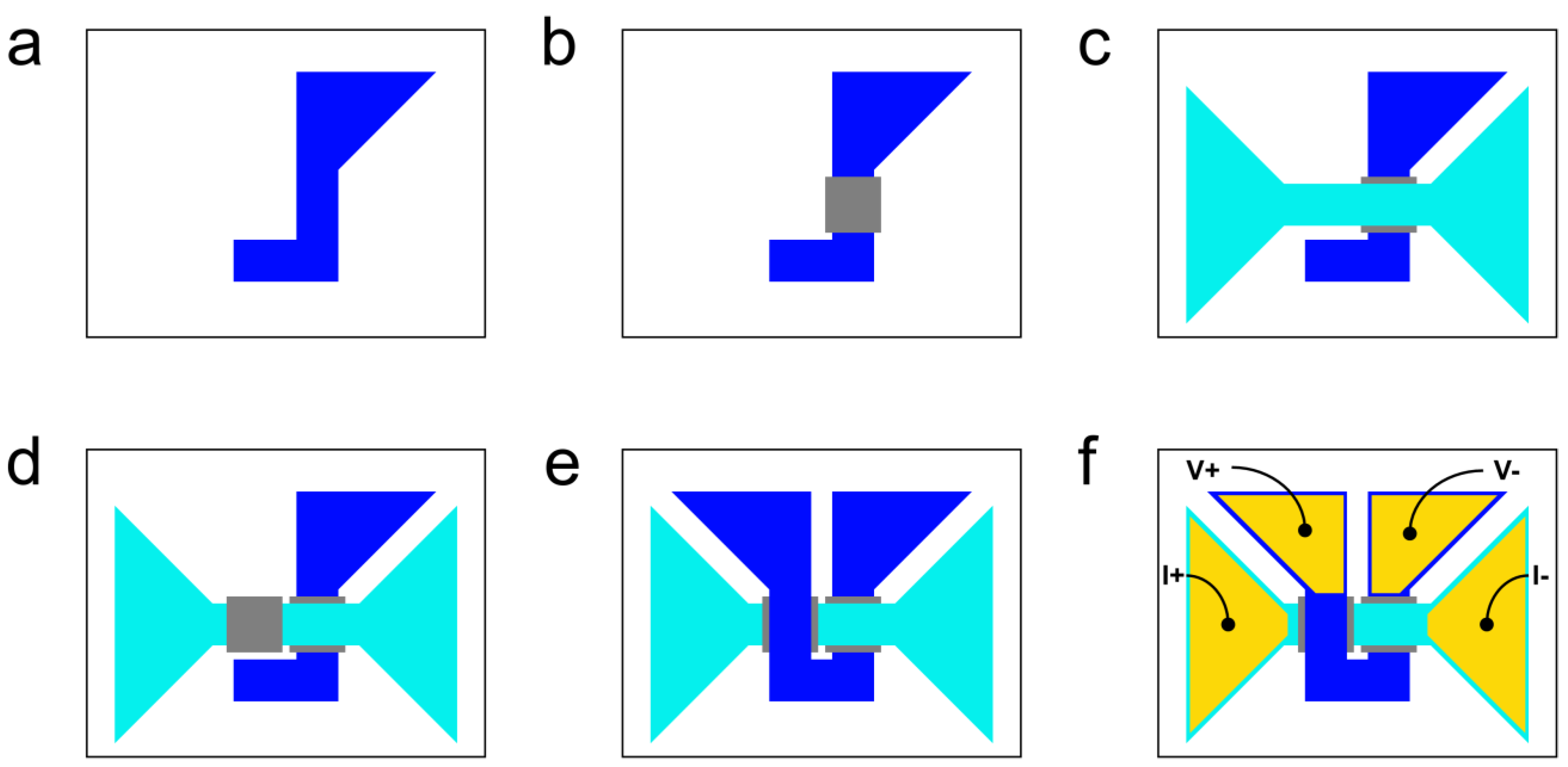Methods to Create Novel La2−xSrxCuO4 Devices with Multiple Atomically Sharp Interfaces
Abstract
1. Introduction
2. Tunnel Junctions
2.1. Tunnel Junction Fabrication
2.2. Tunnel Junction Results
3. Josephson Junctions
3.1. Josephson Junction Fabrication
3.2. Preliminary Measurements
4. Dyon Detectors
Proposed Dyon Detector Fabrication
5. Conclusions
Author Contributions
Funding
Data Availability Statement
Conflicts of Interest
References
- Bednorz, J.G.; Müller, K.A. Possible High Tc Superconductivity in the Ba−La−Cu−O System. Z. Phys. B Condens. Matter 1986, 64, 189–193. [Google Scholar] [CrossRef]
- Cava, R.J.; van Dover, R.B.; Batlogg, B.; Rietman, E.A. Bulk Superconductivity at 36 K in La1.8Sr0.2CuO4. Phys. Rev. Lett. 1987, 58, 408–410. [Google Scholar] [CrossRef] [PubMed]
- Wu, M.K.; Ashburn, J.R.; Torng, C.J.; Hor, P.H.; Meng, R.L.; Gao, L.; Huang, Z.J.; Wang, Y.Q.; Chu, C.W. Superconductivity at 93 K in a New Mixed-Phase Y-Ba-Cu-O Compound System at Ambient Pressure. Phys. Rev. Lett. 1987, 58, 908–910. [Google Scholar] [CrossRef] [PubMed]
- Hazen, R.M.; Prewitt, C.T.; Angel, R.J.; Ross, N.L.; Finger, L.W.; Hadidiacos, C.G.; Veblen, D.R.; Heaney, P.J.; Hor, P.H.; Meng, R.L.; et al. Superconductivity in the High-T, Bi-Ca-Sr-Cu-O System: Phase Identification. Phys. Rev. Lett. 1988, 60, 1174–1177. [Google Scholar] [CrossRef]
- Sheng, Z.Z.; Hermann, A.M. Bulk superconductivity at 120 K in the Tl-Ca/Ba-Cu-O system. Nature 1988, 332, 138–139. [Google Scholar] [CrossRef]
- Schilling, A.; Cantoni, M.; Guo, J.D.; Ott, H.R. Superconductivity above 130 K in the Hg-Ba-Ca-Cu-O system. Nature 1993, 363, 56–58. [Google Scholar] [CrossRef]
- Vaknin, D.; Sinha, S.K.; Moncton, D.E.; Johnston, D.C.; Newsam, J.M.; Safinya, C.R.; King, H.E., Jr. Antiferromagnetism in La2CuO4-y. Phys. Rev. Lett. 1987, 58, 2802–2805. [Google Scholar] [CrossRef]
- Mitsuda, S.; Shirane, G.; Sinha, S.K.; Johnston, D.C.; Alvarez, M.S.; Vaknin, D.; Moncton, D.E. Confirmation of antiferromagnetism in La2CuO4-y with polarized neutrons. Phys. Rev. B 1987, 36, 822–825. [Google Scholar] [CrossRef]
- Freltoft, T.; Remeika, J.P.; Moncton, D.E.; Cooper, A.S.; Fischer, J.E.; Harshman, D.; Shirane, G.; Sinha, S.K.; Vaknin, D. Antiferromagnetism and oxygen deficiency in single-crystal La2CuO4-δ. Phys. Rev. B 1987, 36, 826–828. [Google Scholar] [CrossRef]
- Tranquada, J.M.; Sternlieb, B.J.; Axe, J.D.; Nakamura, Y.; Uchida, S. Evidence for stripe correlations of spins and holes in copper oxide superconductors. Nature 1995, 375, 561–563. [Google Scholar] [CrossRef]
- Suzuki, T.; Goto, T.; Chiba, K.; Shinoda, T.; Fukase, T.; Kimura, H.; Yamada, K.; Ohashi, M.; Yamaguchi, Y. Observation of modulated magnetic long-range order in La1.88Sr0.12CuO4. Phys. Rev. B 1998, 57, R3229–R3232. [Google Scholar] [CrossRef]
- Kimura, H.; Matsushita, H.; Hirota, K.; Endoh, Y.; Yamada, K.; Shirane, G.; Lee, Y.S.; Kastner, M.A.; Birgeneau, R.J. Incommensurate geometry of the elastic magnetic peaks in superconducting La1.88Sr0.12CuO4. Phys. Rev. B 2000, 61, 14366–14369. [Google Scholar] [CrossRef]
- Lake, B.; Rønnow, H.M.; Christensen, N.B.; Aeppli, G.; Lefmann, K.; McMorrow, D.F.; Vorderwisch, P.; Smeibidl, P.; Mangkorntong, N.; Sasagawa, T.; et al. Antiferromagnetic order induced by an applied magnetic field in a high-temperature superconductor. Nature 2002, 415, 299–301. [Google Scholar] [CrossRef] [PubMed]
- Kivelson, S.A.; Bindloss, I.P.; Fradkin, E.; Oganesyan, V.; Tranquada, J.M.; Kapitulnik, A.; Howald, C. How to detect fluctuating stripes in the high-temperature superconductors. Rev. Mod. Phys. 2003, 75, 1201–1241. [Google Scholar] [CrossRef]
- Fujita, M.; Goka, H.; Yamada, K.; Tranquada, J.M.; Regnault, L.P. Stripe order, depinning and fluctuations in La1.875Ba0.125CuO4 and La1.875Ba0.075Sr0.050CuO4. Phys. Rev. B 2004, 70, 104517. [Google Scholar] [CrossRef]
- Lee, S.; Huang, E.W.; Johnson, T.A.; Guo, X.; Husain, A.A.; Mitrano, M.; Lu, K.; Zakrzewski, A.V.; de la Peña, G.A.; Peng, Y.; et al. Generic character of charge and spin density waves in superconducting cuprates. Proc. Natl. Acad. Sci. USA 2022, 119, e2119429119. [Google Scholar] [CrossRef]
- Hoffman, J.E.; Hudson, E.W.; Lang, K.M.; Madhavan, V.; Eisaki, H.; Uchida, S.; Davis, J.C. A Four Unit Cell Periodic Pattern of Quasi-Particle States Surrounding Vortex Cores in Bi2Sr2CaCu2O8+δ. Science 2002, 295, 466–469. [Google Scholar] [CrossRef]
- Abbamonte, P.; Rusydi, A.; Smadici, S.; Gu, G.D.; Sawatzky, G.A.; Feng, D.L. Spatially modulated ‘Mottness’ in La2-xBaxCuO4. Nat. Phys. 2005, 1, 15–158. [Google Scholar] [CrossRef]
- Wise, W.D.; Boyer, M.C.; Chatterjee, K.; Kondo, T.; Takeuchi, T.; Ikuta, H.; Wang, Y.; Hudson, E.W. Charge-density-wave origin of cuprate checkerboard visualized by scanning tunnelling microscopy. Nat. Phys. 2008, 4, 696–699. [Google Scholar] [CrossRef]
- Parker, C.V.; Aynajian, P.; da Silva Neto, E.H.; Pushp, A.; Ono, S.; Wen, J.; Xu, Z.; Gu, G.; Yazdani, A. Fluctuating stripes at the onset of the pseudogap in the high-Tc superconductor Bi2Sr2CaCu2O8+x. Nature 2010, 468, 677–680. [Google Scholar] [CrossRef]
- Wu, T.; Mayaffre, H.; Krämer, S.; Horvatić, M.; Berthier, C.; Hardy, W.N.; Liang, R.; Bonn, D.A.; Julien, M.-H. Magnetic-field-induced charge-stripe order in the high-temperature superconductor YBa2Cu3Oy. Nature 2011, 477, 191–194. [Google Scholar] [CrossRef] [PubMed]
- Ghiringhelli, G.; Le Tacon, M.; Minola, M.; Blanco-Canosa, S.; Mazzoli, C.; Brookes, N.B.; De Luca, G.M.; Frano, A.; Hawthorn, D.G.; He, F.; et al. Long-Range Incommensurate Charge Fluctuations in (Y,Nd)Ba2Cu3O6+x. Science 2012, 337, 821–825. [Google Scholar] [CrossRef] [PubMed]
- Chang, J.; Blackburn, E.; Holmes, A.T.; Christensen, N.B.; Larsen, J.; Mesot, J.; Liang, R.; Bonn, D.A.; Hardy, W.N.; Watenphul, A.; et al. Direct observation of competition between superconductivity and charge density wave order in YBa2Cu3O6.67. Nat. Phys. 2012, 8, 871–876. [Google Scholar] [CrossRef]
- Torchinsky, D.; Mahmood, F.; Bollinger, A.T.; Božović, I.; Gedik, N. Fluctuating charge-density waves in a cuprate superconductor. Nat. Mater. 2013, 12, 387–391. [Google Scholar] [CrossRef] [PubMed]
- Miao, H.; Lorenzana, J.; Seibold, G.; Peng, Y.Y.; Amorese, A.; Yakhou-Harris, F.; Kummer, K.; Brookes, N.B.; Konik, R.M.; Thampy, V.; et al. High-temperature charge density wave correlations in La1.875Ba0.125CuO4 without spin–charge locking. Proc. Natl. Acad. Sci. USA 2017, 114, 12430–12435. [Google Scholar] [CrossRef]
- Miao, H.; Ishikawa, D.; Heid, R.; Le Tacon, M.; Fabbris, G.; Meyers, D.; Gu, G.D.; Baron, A.Q.R.; Dean, M.P.M. Incommensurate Phonon Anomaly and the Nature of Charge Density Waves in Cuprates. Phys. Rev. X 2018, 8, 011008. [Google Scholar] [CrossRef]
- Miao, H.; Fumagalli, R.; Rossi, M.; Lorenzana, J.; Seibold, G.; Yakhou-Harris, F.; Kummer, K.; Brookes, N.B.; Gu, G.D.; Braicovich, L.; et al. Formation of Incommensurate Charge Density Waves in Cuprates. Phys. Rev. X 2019, 9, 031042. [Google Scholar] [CrossRef]
- Miao, H.; Fabbris, G.; Koch, R.J.; Mazzone, D.G.; Nelson, C.S.; Acevedo-Esteves, R.; Gu, G.D.; Li, Y.; Yilmaz, T.; Kaznatcheev, K.; et al. Charge density waves in cuprate superconductors beyond the critical doping. NPJ Quantum Mater. 2021, 6, 31. [Google Scholar] [CrossRef]
- Mirzaei, S.I.; Stricker, D.; Hancock, J.N.; Berthod, C.; Georges, A.; van Heumen, E.; Chan, M.K.; Zhao, X.; Li, Y.; Greven, M.; et al. Spectroscopic evidence for Fermi liquid-like energy and temperature dependence of the relaxation rate in the pseudogap phase of the cuprates. Proc. Natl. Acad. Sci. USA 2013, 110, 5774–5778. [Google Scholar] [CrossRef]
- Barišić, N.; Chan, M.K.; Li, Y.; Yu, G.; Zhao, X.; Dressel, M.; Smontara, A.; Greven, M. Universal sheet resistance and revised phase diagram of the cuprate high-temperature superconductors. Proc. Natl. Acad. Sci. USA 2013, 110, 12235–12240. [Google Scholar] [CrossRef]
- Li, Y.; Tabis, W.; Yu, G.; Barišić, N.; Greven, M. Hidden Fermi-liquid Charge Transport in the Antiferromagnetic Phase of the Electron-Doped Cuprate Superconductors. Phys. Rev. Lett. 2016, 117, 197001. [Google Scholar] [CrossRef] [PubMed]
- Proust, C.; Vignolle, B.; Levallois, J.; Adachi, S.; Hussey, N.E. Fermi liquid behavior of the in-plane resistivity in the pseudogap state of YBa2Cu4O8. Proc. Natl. Acad. Sci. USA 2016, 113, 13654–13659. [Google Scholar] [CrossRef] [PubMed]
- Cooper, R.A.; Wang, Y.; Vignolle, B.; Lipscombe, O.J.; Hayden, S.M.; Tanabe, Y.; Adachi, T.; Koike, Y.; Nohara, M.; Takagi, H.; et al. Anomalous Criticality in the Electrical Resistivity of La2−xSrxCuO4. Science 2009, 323, 603–607. [Google Scholar] [CrossRef]
- Bruin, J.A.N.; Sakai, H.; Perry, R.S.; Mackenzie, A.P. Similarity of Scattering Rates in Metals Showing T-linear Resistivity. Science 2013, 339, 804–807. [Google Scholar] [CrossRef] [PubMed]
- Giraldo-Gallo, P.; Galvis, J.A.; Stegen, Z.; Modic, K.A.; Balakirev, F.F.; Betts, J.B.; Lian, X.; Moir, C.; Riggs, S.C.; Wu, J.; et al. Scale-invariant magnetoresistance in a cuprate superconductor. Science 2018, 361, 479–481. [Google Scholar] [CrossRef]
- Legros, A.; Benhabib, S.; Tabis, W.; Laliberté, F.; Dion, M.; Lizaire, M.; Vignolle, B.; Vignolles, D.; Raffy, H.; Li, Z.Z.; et al. Universal T-linear resistivity and Planckian dissipation in overdoped cuprates. Nat. Phys. 2019, 15, 142–147. [Google Scholar] [CrossRef]
- Greene, R.L.; Mandal, P.R.; Poniatowski, N.R.; Sarkar, T. The Strange Metal State of the Electron-Doped Cuprates. Annu. Rev. Condens. Matter Phys. 2020, 11, 213–229. [Google Scholar] [CrossRef]
- Varma, C.M. Linear in temperature resistivity and associated mysteries including high temperature superconductivity. Rev. Mod. Phys. 2020, 92, 031001. [Google Scholar] [CrossRef]
- Putzke, C.; Benhabib, S.; Tabis, W.; Ayres, J.; Wang, Z.; Malone, L.; Licciardello, S.; Lu, J.; Kondo, T.; Takeuchi, T.; et al. Reduced Hall carrier density in the overdoped strange metal regime of cuprate superconductors. Nat. Phys. 2021, 17, 826–831. [Google Scholar] [CrossRef]
- Ayres, J.; Berben, M.; Čulo, M.; Hsu, Y.-T.; van Heumen, E.; Huang, Y.; Zaanen, J.; Kondo, T.; Takeuchi, T.; Cooper, J.R.; et al. Incoherent transport across the strange-metal regime of overdoped cuprates. Nature 2021, 595, 661–666. [Google Scholar] [CrossRef]
- Ando, Y.; Segawa, K.; Komiya, S.; Lavrov, A.N. Electrical Resistivity Anisotropy from Self-Organized One Dimensionality in High-Temperature Superconductors. Phys. Rev. Lett. 2002, 88, 137005. [Google Scholar] [CrossRef] [PubMed]
- Abdel-Jawad, M.; Kennett, M.P.; Balicas, L.; Carrington, A.; Mackenzie, A.P.; McKenzie, R.H.; Hussey, N.E. Anisotropic scattering and anomalous normal-state transport in a high-temperature superconductor. Nat. Phys. 2006, 2, 821–825. [Google Scholar] [CrossRef]
- Hinkov, V.; Haug, D.; Fauqué, B.; Bourges, P.; Sidis, Y.; Ivanov, A.; Bernhard, C.; Lin, C.T.; Keimer, B. Electronic Liquid Crystal State in the High-Temperature Superconductor YBa2Cu3O6.45. Science 2008, 319, 597–600. [Google Scholar] [CrossRef] [PubMed]
- Lawler, M.J.; Fujita, K.; Lee, J.; Schmidt, A.R.; Kohsaka, Y.; Kim, C.K.; Eisaki, H.; Uchida, S.; Davis, J.C.; Sethna, J.P.; et al. Intra-unit-cell electronic nematicity of the high-Tc copper-oxide pseudogap states. Nature 2010, 466, 347–351. [Google Scholar] [CrossRef]
- Daou, R.; Chang, J.; LeBoeuf, D.; Cyr-Choinière, O.; Laliberté, F.; Doiron-Leyraud, N.; Ramshaw, B.J.; Liang, R.; Bonn, D.A.; Hardy, W.N.; et al. Broken rotational symmetry in the pseudogap phase of a high-Tc superconductor. Nature 2010, 463, 519–522. [Google Scholar] [CrossRef] [PubMed]
- Fradkin, E.; Kivelson, S.A.; Lawler, M.J.; Eisenstein, J.P.; Mackenzie, A.P. Nematic Fermi Fluids in Condensed Matter Physics. Annu. Rev. Cond. Matter Phys. 2010, 1, 153–178. [Google Scholar] [CrossRef]
- Fujita, K.; Kim, C.K.; Lee, I.; Hamidian, M.H.; Firmo, I.A.; Mukhopadhyay, S.; Eisaki, H.; Uchida, S.; Lawler, M.J.; Kim, E.-A.; et al. Simultaneous Transitions in Cuprate Momentum-Space Topology and Electronic Symmetry Breaking. Science 2014, 344, 612–616. [Google Scholar] [CrossRef]
- Lubashevsky, Y.; Pan, L.D.; Kirzhner, T.; Koren, G.; Armitage, N.P. Optical Birefringence and Dichroism of Cuprate Superconductors in the THz Regime. Phys. Rev. Lett. 2014, 112, 147001. [Google Scholar] [CrossRef]
- Cyr-Choinière, O.; Grissonnanche, G.; Badoux, S.; Day, J.; Bonn, D.A.; Hardy, W.N.; Liang, R.; Doiron-Leyraud, N.; Taillefer, L. Two types of nematicity in the phase diagram of the cuprate superconductor YBa2Cu3Oy. Phys. Rev. B 2015, 92, 224502. [Google Scholar] [CrossRef]
- Zhang, J.; Levenson-Falk, E.M.; Ramshaw, B.J.; Bonn, D.A.; Liang, R.; Hardy, W.N.; Hartnoll, S.A.; Kapitulnik, A. Anomalous thermal diffusivity in underdoped YBa2Cu3O6+x. Proc. Natl. Acad. Sci. USA 2017, 114, 5378–5383. [Google Scholar] [CrossRef]
- Zhao, L.; Belvin, C.A.; Liang, R.; Bonn, D.A.; Hardy, W.N.; Armitage, N.P.; Hsieh, D.A. A global inversion-symmetry-broken phase inside the pseudogap region of YBa2Cu3Oy. Nat. Phys. 2017, 13, 250–254. [Google Scholar] [CrossRef]
- Sato, Y.; Kasahara, S.; Murayama, H.; Kasahara, Y.; Moon, E.-G.; Nishizaki, T.; Loew, T.; Porras, J.; Keimer, B.; Shibauchi, T.; et al. Thermodynamic evidence for a nematic phase transition at the onset of the pseudogap in YBa2Cu3Oy. Nat. Phys. 2017, 13, 1074–1078. [Google Scholar] [CrossRef]
- Wu, J.; Bollinger, A.T.; He, X.; Božović, I. Spontaneous breaking of rotational symmetry in copper oxide superconductors. Nature 2017, 547, 432–435. [Google Scholar] [CrossRef] [PubMed]
- Ohtomo, A.; Hwang, H.Y. A high-mobility electron gas at the LaAlO3/SrTiO3 heterointerface. Nature 2004, 427, 423–426. [Google Scholar] [CrossRef] [PubMed]
- Tsukazaki, A.; Ohtomo, A.; Kita, A.T.; Ohno, Y.; Ohno, H.; Kawasaki, M. Quantum Hall Effect in Polar Oxide Heterostructures. Science 2007, 315, 1388–1391. [Google Scholar] [CrossRef]
- Brinkman, A.; Huijben, M.; van Zalk, M.; Huijben, J.; Zeitler, U.; Maan, J.C.; van der Wiel, W.G.; Rijnderss, G.; Blank, D.H.A.; Hilgenkamp, H. Magnetic effects at the interface between non-magnetic oxides. Nat. Mater. 2007, 6, 493–496. [Google Scholar] [CrossRef]
- Reyren, N.; Thiel, S.; Caviglia, A.D.; Kourkoutis, L.F.; Hammerl, G.; Richter, C.; Schneider, C.W.; Kopp, T.; Rüetschi, A.-S.; Jaccard, D.; et al. Superconducting Interfaces Between Insulating Oxides. Science 2007, 317, 1196–1199. [Google Scholar] [CrossRef] [PubMed]
- Bhattacharya, A.; May, S.J.; te Velthuis, S.G.E.; Warusawithana, M.; Zhai, X.; Jiang, B.; Zuo, J.-M.; Fitzsimmons, M.R.; Bader, S.D.; Eckstein, J.N. Metal-Insulator Transition and Its Relation to Magnetic Structure in (LaMnO3)2n/(SrMnO3)n Superlattices. Phys. Rev. Lett. 2008, 100, 257203. [Google Scholar] [CrossRef]
- Gozar, A.; Logvenov, G.; Fitting Kourkoutis, L.; Bollinger, A.T.; Giannuzzi, L.A.; Muller, D.A.; Bozovic, I. High-temperature interface superconductivity between metallic and insulating copper oxides. Nature 2008, 455, 782–785. [Google Scholar] [CrossRef]
- Wu, J.; Pelleg, O.; Logvenov, G.; Bollinger, A.T.; Sun, Y.-J.; Boebinger, G.S.; Vanević, M.; Radović, Z.; Božović, I. Anomalous independence of interface superconductivity from carrier density. Nat. Mater. 2013, 12, 877–881. [Google Scholar] [CrossRef]
- Butko, V.Y.; Logvenov, G.; Božović, N.; Radović, Z.; Božović, I. Madelung Strain in Cuprate Superconductors—A Route to Enhancement of the Critical Temperature. Adv. Mater. 2009, 21, 3644–3648. [Google Scholar] [CrossRef]
- Logvenov, G.; Gozar, A.; Bozovic, I. High-Temperature Superconductivity in a Single Copper-Oxygen Plane. Science 2009, 326, 699–702. [Google Scholar] [CrossRef]
- Smadici, S.; Lee, J.C.T.; Wang, S.; Abbamonte, P.; Logvenov, G.; Gozar, A.; Deville Cavellin, C.; Bozovic, I. Superconducting Transition at 38 K in Insulating-Overdoped La2CuO4−La1.64Sr0.36CuO4 Superlattices: Evidence for Interface Electronic Redistribution from Resonant Soft X-ray Scattering. Phys. Rev. Lett. 2009, 102, 107004. [Google Scholar] [CrossRef]
- Ginzburg, V.L. On surface superconductivity. Phys. Lett. 1964, 13, 101–102. [Google Scholar] [CrossRef]
- Kivelson, S.A. Making high Tc higher: A theoretical proposal. Phys. B Condens. Matter 2002, 318, 61–67. [Google Scholar] [CrossRef]
- Dzhumanov, S.; Solovjov, A.L.; Vovk, R.V.; Grinyov, B.V.; Djumanov, S.S. The possibility of realizing room-temperature superconductivity in High-Tc cuprates in their two-dimensional sandwich layers. Funct. Mater. 2022, 29, 475–480. [Google Scholar] [CrossRef]
- Bozovic, I.; Eckstein, J.N.; Virshup, G.F.; Chaiken, A.; Wall, M.; Howell, R.; Fluss, M. Atomic-Layer Engineering of Cuprate Superconductors. J. Supercond. 1994, 7, 187–195. [Google Scholar] [CrossRef]
- Schlom, D.G.; Harris, J.S., Jr. MBE Growth of High Tc Superconductors. In Molecular Beam Epitaxy; Farrow, R.F.C., Ed.; Noyes Publications: Park Ridge, NJ, USA, 1995; pp. 504–622. [Google Scholar] [CrossRef]
- Bozovic, I. Atomic-Layer Engineering of Superconducting Oxides: Yesterday, Today, Tomorrow. IEEE Trans. Appl. Supercond. 2001, 11, 2686–2695. [Google Scholar] [CrossRef]
- Bollinger, A.T.; Božović, I. Two-dimensional superconductivity in the cuprates revealed by atomic-layer-by-layer molecular beam epitaxy. Supercond. Sci. Technol. 2016, 29, 103001. [Google Scholar] [CrossRef]
- Bozovic, I.; Logvenov, G.; Verhoeven, M.A.J.; Caputo, P.; Goldobin, E.; Geballe, T.H. No mixing of superconductivity and antiferromagnetism in a high-temperature superconductor. Nature 2003, 422, 873–875. [Google Scholar] [CrossRef]
- Bozovic, I.; Logvenov, G.; Verhoeven, M.A.J.; Caputo, P.; Goldobin, E.; Beasley, M.R. Giant Proximity Effect in Cuprate Superconductors. Phys. Rev. Lett. 2004, 93, 157002. [Google Scholar] [CrossRef] [PubMed]
- Zhou, P.; Chen, L.; Liu, Y.; Sochnikov, I.; Bollinger, A.T.; Han, M.-G.; Zhu, Y.; He, X.; Božović, I.; Natelson, D. Electron pairing in the pseudogap state revealed by shot noise in copper oxide junctions. Nature 2019, 572, 493–496. [Google Scholar] [CrossRef] [PubMed]
- Zhou, P.; Chen, L.; Sochnikov, I.; Wu, T.C.; Foster, M.S.; Bollinger, A.T.; He, X.; Božović, I.; Natelson, D. Tunneling spectroscopy of c-axis epitaxial cuprate junctions. Phys. Rev. B 2020, 101, 224512. [Google Scholar] [CrossRef]
- Ozyuzer, L.; Zasadzinski, J.F.; Kendziora, C.; Gray, K.E. Quasiparticle and Josephson tunneling of overdoped Bi2Sr2CaCu2O8+δ. Phys. Rev. B 1999, 61, 3629–3640. [Google Scholar] [CrossRef]
- Sharoni, A.; Koren, G.; Millo, O. Correlation of tunneling spectra with surface nanomorphology and doping in thin YBa2Cu3O7−δ. EPL 2001, 54, 675–681. [Google Scholar] [CrossRef]
- Zhao, H.; Ren, Z.; Rachmilowitz, B.; Schneeloch, J.; Zhong, R.; Gu, G.; Wang, Z.; Zeljkovic, I. Charge-stripe crystal phase in an insulating cuprate. Nat. Mater. 2019, 18, 103–107. [Google Scholar] [CrossRef]
- Bollinger, A.T.; He, X.; Xu, X.; Shi, X.; Božović, I. Method to create cuprate tunnel junctions with atomically sharp interfaces. J. Vac. Sci. Technol. B 2022, 40, 015001. [Google Scholar] [CrossRef]
- Xu, X.; He, X.; Bollinger, A.T.; Han, M.-G.; Zhu, Y.; Shi, X.; Božović, I. A method to probe the interfaces in La2-xSrxCuO4-LaSrAlO4-La2-xSrxCuO4 trilayer junctions. Condens. Matter, 2023; submitted. [Google Scholar]
- Diamantini, M.C.; Trugenberger, C.A.; Bollinger, A.T.; Vinokur, V.M.; Božović, I. Topological Model of the Pseudogap State: Experimental Signatures. Front. Phys. 2022, 9, 756760. [Google Scholar] [CrossRef]





Disclaimer/Publisher’s Note: The statements, opinions and data contained in all publications are solely those of the individual author(s) and contributor(s) and not of MDPI and/or the editor(s). MDPI and/or the editor(s) disclaim responsibility for any injury to people or property resulting from any ideas, methods, instructions or products referred to in the content. |
© 2023 by the authors. Licensee MDPI, Basel, Switzerland. This article is an open access article distributed under the terms and conditions of the Creative Commons Attribution (CC BY) license (https://creativecommons.org/licenses/by/4.0/).
Share and Cite
Bollinger, A.T.; He, X.; Caruso, R.; Xu, X.; Shi, X.; Božović, I. Methods to Create Novel La2−xSrxCuO4 Devices with Multiple Atomically Sharp Interfaces. Condens. Matter 2023, 8, 14. https://doi.org/10.3390/condmat8010014
Bollinger AT, He X, Caruso R, Xu X, Shi X, Božović I. Methods to Create Novel La2−xSrxCuO4 Devices with Multiple Atomically Sharp Interfaces. Condensed Matter. 2023; 8(1):14. https://doi.org/10.3390/condmat8010014
Chicago/Turabian StyleBollinger, Anthony T., Xi He, Roberta Caruso, Xiaotao Xu, Xiaoyan Shi, and Ivan Božović. 2023. "Methods to Create Novel La2−xSrxCuO4 Devices with Multiple Atomically Sharp Interfaces" Condensed Matter 8, no. 1: 14. https://doi.org/10.3390/condmat8010014
APA StyleBollinger, A. T., He, X., Caruso, R., Xu, X., Shi, X., & Božović, I. (2023). Methods to Create Novel La2−xSrxCuO4 Devices with Multiple Atomically Sharp Interfaces. Condensed Matter, 8(1), 14. https://doi.org/10.3390/condmat8010014








